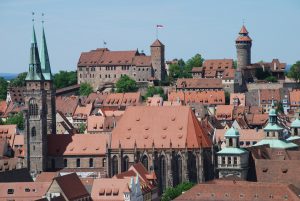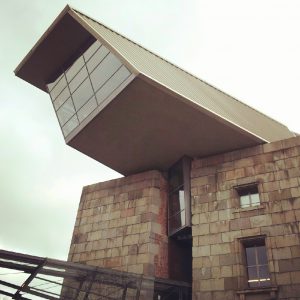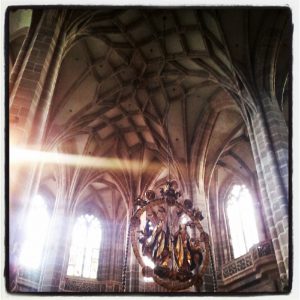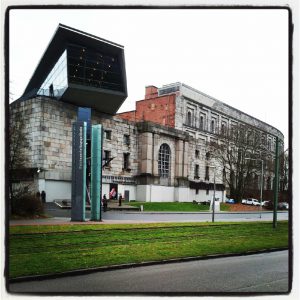Nuremberg, Germany
By Tracy A. Burns
 In Nuremberg, you can walk through a medieval castle, admire medieval churches and visit breathtaking museums. It is also a city of oriels, with about 80 in the city. Innovative fountains also dot the historical center. Of course, the beer, bratwurst, and gingerbread are delicious.
In Nuremberg, you can walk through a medieval castle, admire medieval churches and visit breathtaking museums. It is also a city of oriels, with about 80 in the city. Innovative fountains also dot the historical center. Of course, the beer, bratwurst, and gingerbread are delicious.
Nuremberg from its founding through the 16th century
Currently home to approximately 500,000 people and the second-largest city in Bavaria, Nuremberg can trace its beginnings to a fortress founded around 1040. Even during the Middle Ages, the town was not without ethnic tensions. In 1349 half of its Jewish population died in a pogrom. Nuremberg became an Imperial City in 1356 when Holy Roman Emperor Charles IV declared that the first day of the Imperial Diet – a meeting of the seven electors to choose the new king – had to take place there. At the same time, the city was designated as a stop along the eastern trade route, allowing merchants to prosper. From 1424 to 1796, the Imperial crown jewels called this town home. Emperor Charles IV, who brought into being the Charles Bridge, New Town, and Charles University in Prague, liked Nuremberg so much that he visited it 52 times. Many inventors and acclaimed artists lived there. For instance, Martin Behaim invented the first globe, and Peter Heinlein created the first pocket watch. Sculptors Adam Kraft and Veit Stoss decorated the churches with their medieval artworks. Nuremberg became a Protestant town in the 16th century. The seven electors gathered there for the last time in 1542.
From the Thirty Years’ War through World War II
 During the Thirty Years’ War, even though the city took a neutral stance, more than 35,000 people perished. Badly in debt, Nuremberg became part of the Bavarian Kingdom in 1806. The 19th century was a time of industrialization. The darkest days in the city’s history, however, began when the National Socialist Party held its first rally there in 1927. Eight years later the Nuremberg Laws came into existence, stripping Jews of their basic rights and denying them German citizenship. When the Allies bombed the city on January 2, 1945, about 1,850 people were killed, and most of the historical Nuremberg was destroyed. From 1945 to 1949, the Nuremberg trials, which prosecuted political and military leaders of the Third Reich, were held in the Congress Hall, an example of Albert Speer’s dehumanizing architecture, a gigantic place that can be visited today.
During the Thirty Years’ War, even though the city took a neutral stance, more than 35,000 people perished. Badly in debt, Nuremberg became part of the Bavarian Kingdom in 1806. The 19th century was a time of industrialization. The darkest days in the city’s history, however, began when the National Socialist Party held its first rally there in 1927. Eight years later the Nuremberg Laws came into existence, stripping Jews of their basic rights and denying them German citizenship. When the Allies bombed the city on January 2, 1945, about 1,850 people were killed, and most of the historical Nuremberg was destroyed. From 1945 to 1949, the Nuremberg trials, which prosecuted political and military leaders of the Third Reich, were held in the Congress Hall, an example of Albert Speer’s dehumanizing architecture, a gigantic place that can be visited today.
The Old Town Hall
The Old Town Hall hails from the 17th century and is built in the Italian Renaissance style. Trials, imperial assemblies, and the signing of peace treaties all have taken place in the Great Council Chamber, which boasts a splendid coffered ceiling.
The Imperial Castle
The Imperial Castle is indeed a highlight of the city and includes the Imperial Apartments, Double Chapel, Sinwell Tower, and the Deep Well. Emperor Heinrich III established the first fortress on this site before 1050. From 1050 to 1571 every German emperor traveled to the castle. Visit the Knights’ Hall with its stunning coffered ceiling. Late Gothic frescoes also decorate the castle. The Romanesque Double Chapel shows the distinct barriers between social classes. Commoners entered from the outer courtyard while the emperor and his entourage came in from the upper floor.
Saint Sebald’s Church
Saint Sebald’s Church contains the Shrine of Holy Sacraments from 1370, a baptismal font from 1430, and Saint Peter’s Altar from 1480. Many of the statues hail from the 15th century. The Gothic nave is breathtaking as are the Gothic windows. Saint Sebald’s tomb is richly decorated and took 11 years to build.
The Church of Our Lady
 The Church of Our Lady was designed by Peter Parler, whose resume also includes Saint Vitus Cathedral in Prague. It features a clock that puts on a show at noon every day. Two trumpeters announce the arrival of King Charles IV, and the seven electors, clad in red, parade around him three times. A Late Gothic Madonna – the Madonna of the Radiant Nimbus – hails from 1440. Kraft’s works are found there, too. The Tucher Altar is sure to amaze. Nearby, in the main square called the Hauptmarkt, is the Beautiful Fountain, which reaches 19 meters and is shaped like a pyramid. It boasts vibrant colors and 40 sculptural figures. Admire the splendid latticework.
The Church of Our Lady was designed by Peter Parler, whose resume also includes Saint Vitus Cathedral in Prague. It features a clock that puts on a show at noon every day. Two trumpeters announce the arrival of King Charles IV, and the seven electors, clad in red, parade around him three times. A Late Gothic Madonna – the Madonna of the Radiant Nimbus – hails from 1440. Kraft’s works are found there, too. The Tucher Altar is sure to amaze. Nearby, in the main square called the Hauptmarkt, is the Beautiful Fountain, which reaches 19 meters and is shaped like a pyramid. It boasts vibrant colors and 40 sculptural figures. Admire the splendid latticework.
Saint Lawrence’s Church
A rose window between two towers dominates the façade of Saint Lawrence’s Church. A sculpted narrative in the arch of the main door portrays scenes from the life of Christ and the Passion. The Adoration Madonna (1285) ranks among the oldest sculptures in the city. Perhaps the highlight of the church is the Representation of the Annunciation, suspended from the vaulted ceiling. The wreath around Gabriel, the Virgin Mary, and the others are sprinkled with 55 roses. A 20-meter high tabernacle is decorated with a pictorial depiction of The Passion.
Museums
Reproductions of Albrecht Dürer’s copperplates, woodcuts, portraits, etchings, and sketches are on display at the Dürer Museum, where Dürer lived from 1509 until his death in 1528. The furnishings hail from the early 16th century. The German National Museum is the largest museum of German art and cultural history. Exhibitions focus on prehistoric times to the modern era. Paintings, sculptures, and artifacts from the 16th century to the present make up one section of the museum, which also shows off the largest collection of pianos in the world. Look at the first globe, created by Behaim in 1491 and 1492, and see that the Americas are notably absent.
Congress Center
 The Congress Center, used for Nazi Party rallies from 1933 to 1938, is larger than Rome’s Coliseum. Speer’s creation was heavily damaged in air attacks by the Allied Forces. Today there is a Documentation Center Museum focusing on the Third Reich and its causes. At the Palace of Justice nearby, do not miss courtroom 600, where the Nuremberg Trials were held from 1945 to 1946.
The Congress Center, used for Nazi Party rallies from 1933 to 1938, is larger than Rome’s Coliseum. Speer’s creation was heavily damaged in air attacks by the Allied Forces. Today there is a Documentation Center Museum focusing on the Third Reich and its causes. At the Palace of Justice nearby, do not miss courtroom 600, where the Nuremberg Trials were held from 1945 to 1946.
A charming city
Come to Nuremberg at Christmas or Easter to visit the large markets that fill up the Hauptmarkt. Stand on the Museum Bridge and gaze at the picturesque Pegnitz River flowing by the Holy Ghost Hospital. Enjoy the Renaissance garden at the Tucher Castle. Visit the zoo. Go shopping on Tanner’s Lane. Step into the Historical Art Bunker, where many artworks were hidden during World War II. Nuremberg will charm you, no matter which sightseeing itinerary you choose.




